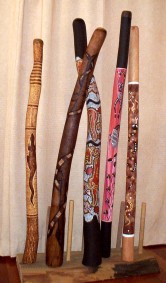 |
Didgeridoos: Art on Didges
BACKGROUND TO THE CONTEMPORARY ABORIGINAL ART FROM THE DREAMING DEPARTMENT OF EDUCATION SA
It is important to realise that, to many Aboriginal artists, the distinctions between art, craft and design and the divisions between traditional and contemporary art based on European understandings of art. They consider this type of analysis to be largely irrelevant, and don't necessary refer to their paintings as art.
|
Many Aboriginal artists work in their chosen field because the art comes out of their culture, beliefs and history and it provides a way to sustain life, both economically as well as culturally and spiritually.
In more traditional areas, art may bring in money or goods, which can then be distributed according to the traditional law, so art strengthens the Dreaming. In less traditional areas, art can bring in the money required to live in a money economy, as well as teach others, Aboriginal and non Aboriginal about history and culture.
"In Aboriginal languages, there is no one definition for the term art. Aboriginal art is our expression, our culture, our living. An extension of our identity. Not just an item for a wall or living room. Aboriginal art is painting, sculpture, dance film making, photography song writing etc."
Brenda Croft – Boomalli
Aboriginal art may be functional, serving practical, spiritual or ceremonial purposes, but, like other art, it also reflects the personal and distinctive manner of the artist. It reflects the values of the culture in which the artist lives and it is often understood only by a limited and informed audience.
Visual art is only one way of expressing Aboriginal Dreaming. It is also expressed through song, through dance, story, law, rituals, craft activities, making implements and other aspects of daily life. While in the past, the Dreaming was painted on cave walls, on bodies and on the ground, it is now painted on bark and canvas as well, but still relates to the Dreaming, even those works which symbolise dispossession and alienation.
Aboriginal artists who use European methods and materials such as watercolour landscapes, acrylic paints on canvas, lino prints and figurative imagery should not be denigrated as not being real Aboriginal artists.
"…….it must be observed that indigenous communities in many parts of the third and fourth worlds are capable of hunting and gathering in our culture, even as we hunt and gather in theirs."
John Heffernen
The heritage of Namitjira – the watercolourists of Central Australia.
Aboriginal culture has always been a living and adapting culture, through interacting with Macassan trading, coping with dramatically changing climates and shifts in coastline over many thousands of years as well as the traumatic effects of the past two hundred years of colonisation. The invasion and settlement by Europeans and others in Australia has resulted in trauma and dispossession for most Aboriginal people who survived.
Aboriginal art has adapted according to local situations. Acrylic paints and canvasses, for example, may be used for commercial purposes, but the art still reflects the Dreaming and culture.
The art of a particular area usually reflects the environment and Dreaming of that area. For example, Albert Namitjira painted the MacDonnell ranges, which is his country. Not Ulluru or the Olgas. However some urban Aboriginal artist now use Australia wide themes and sometimes international themes and symbols.
Much of the painting is done by Aboriginal people in urban areas has been described as contemporary, and this is probably the most accurate term. However, much of the art which has been described as contemporary has elements of the Dreaming and relates to the artist to their culture in a symbolic and spiritual way just as traditional Aboriginal art does. In urban areas, a major difference is that the story or symbols depicted and their particular designs are not always handed down the ancestors. Contemporary Aboriginal artists have often, though not always, been separated from their traditional culture, and their painting or other forms of art have enabled them to express their history, culture and spirituality in diverse but uniquely Aboriginal ways.
|